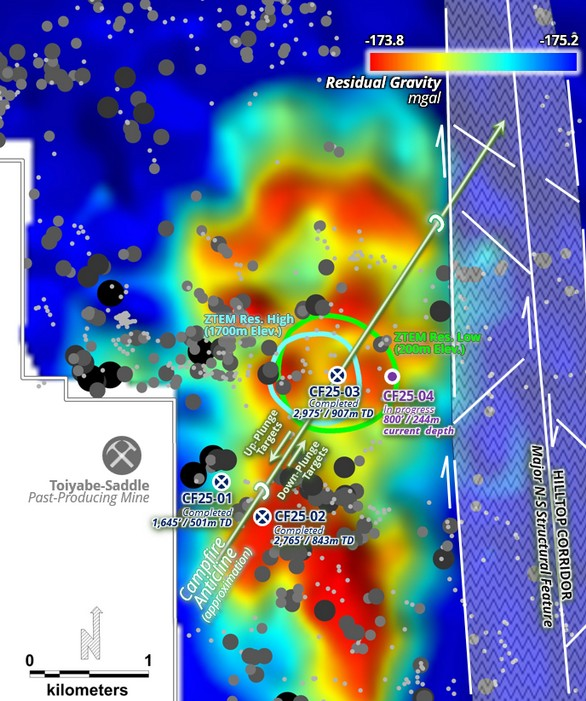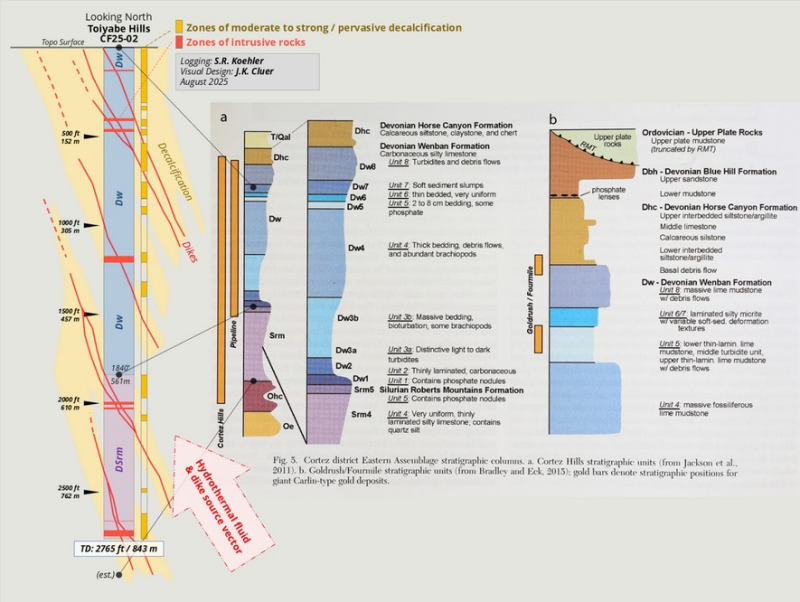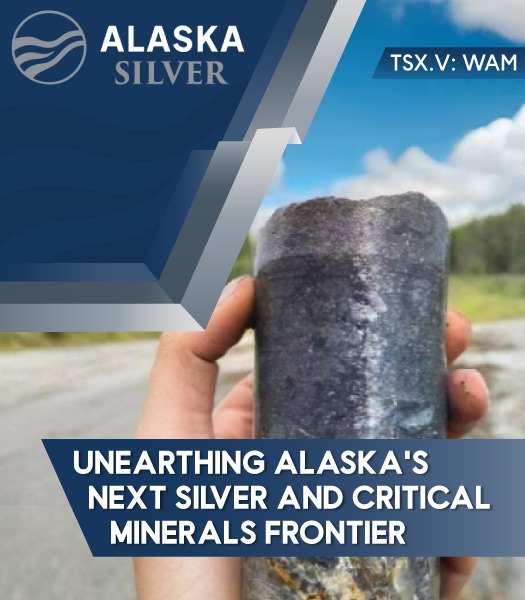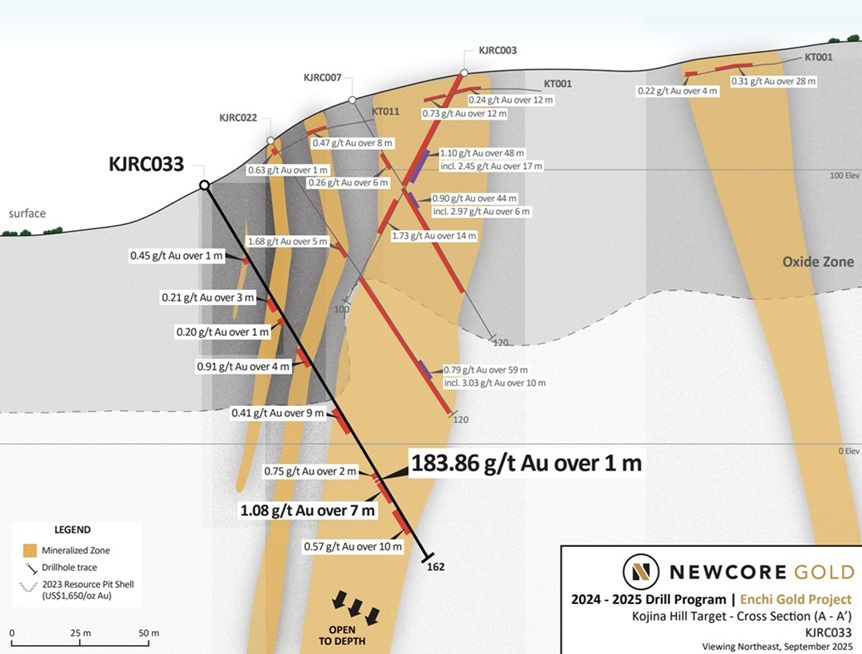- CF25-02 demonstrated vertically-extensive alteration – namely decalcification – and tested the entirety of the Wenban Formation and the majority of the Roberts Mountains Formation, the two most productive stratigraphic horizons in the district
- The first three holes of the campaign have confirmed that lower-plate strata can routinely be reached over the Campfire Target Complex – and therefore a significant portion of the greater Toiyabe Hills Property – with cost-effective reverse-circulation drilling
- Hole CF25-02 was collared in favourable carbonate stratigraphy (which CF25-01 reached at 70m depth) within the up-plunge expression of the Campfire Anticline; CF25-03 was collared down-plunge to the northeast of the first two holes
Vancouver, British Columbia – TheNewswire - August 11, 2025 – Westward Gold Inc. (CSE: WG, OTCQB: WGLIF, FSE: IM50) (“Westward” or the “Company”) is pleased to provide an update on its 2025 drilling campaign, currently underway at its flagship Toiyabe Hills Property in Lander County, Nevada (“Toiyabe Hills”, or the “Property”). Westward is testing its high-priority Campfire Target Complex (“Campfire”) with approximately 5,000 metres (~16,500 feet) of reverse-circulation (“RC”) drilling (see press release date July 8, 2025, for additional details). To date, three holes have been completed (combined depth of 2,251 m) with samples for the first two sent to Paragon Geochemical Services Inc. (“Paragon”) for gold and multi-element analysis (CF25-03 samples are awaiting imminent delivery). CF25-02 was selected as the first hole to undergo detailed logging of RC chips and is described in further detail herein. Hole CF25-04 was recently initiated and drilling at a depth of 244m as of the evening of August 10th; see Figure 1 below for a map of completed and in-progress holes at Campfire.
Figure 1: Completed & In-Progress Drilling – Campfire Target, Toiyabe Hills
Lessons learned during the drilling of CF25-01 enabled the Company to push CF25-02 and CF25-03 to significant depths; as a result, CF25-02 became the first hole ever at Toiyabe Hills to test the Roberts Mountains Formation, an important gold-hosting horizon at nearby mines and major deposits. Based on detailed logging of RC chips, the contact between the Roberts Mountains and the Wenban Formation was estimated at approximately 1,840’ / 560m depth. With CF25-02, the extensive decalcification mapped at surface is now confirmed down-section in both the Wenban and Roberts Mountains Formations – with 13 logged intervals of moderate to strongly-decalcified lower-plate rocks ranging in thickness from 20’ (6.1m) to 310’ (94.5m). The Company also observed eight zones of intrusive rocks, confirming that the intermediate to mafic (lamprophyre) dikes observed at surface are also present at depth in CF25-02 (see Figure 2 below).
Figure 2: CF25-02 Stratigraphic Column w/ Observed Alteration & Intrusive Rock
Steven Koehler, Westward Technical Advisor, commented: “The 2024 Anaconda-style geological mapping provided much-needed surface information regarding the hydrothermal system, structure and host rocks – the three critical ingredients required for a compelling gold target at Toiyabe Hills. Mapping identified the northeast-plunging, igneous dike-filled Campfire Anticline and a variety of stratigraphic and structural target opportunities – the Campfire Target Complex – in the anticline. Westward’s 2025 Phase 1 drilling campaign began at the up-plunge expression of the anticline, where surface exposures of decalcified Wenban Formation limestone crop out. Drill hole CF25-02 intersected multiple zones of altered igneous dikes and vertically-extensive zones of decalcification at depth in the favorable Wenban and Roberts Mountains Formations. It’s a rare day in Nevada to confirm these downhole geological patterns in an underexplored gold system so close to the major Cortez camp. Drilling to date reinforces my confidence in our initial interpretations that Campfire is an expansive Carlin-type hydrothermal system both in plan and in the third dimension at depth.”
Based on detailed logging, the Company has interpreted that CF25-02 was near the Roberts Mountains / Hanson Creek formational contact when the hole was completed. This interpretation was supported by i) a distinct increase in dolomite content as the hole approached its ultimate depth, and ii) the documented thickness of the Roberts Mountains Formation in the district. CF25-03, the first hole of the program to test the down-plunge expression of the Campfire Anticline where it intersects coincident geophysical anomalies, was collared in upper-plate siliciclastic rocks. Based on preliminary logging at the drill rig, Westward estimates that the hole pierced into the Wenban Formation at a depth of 1,005’ / 306m. This represents a significant positive development in the early stages of the campaign: confirmation that lower-plate host rock strata can routinely be reached with RC drilling across the Campfire Complex, and moreover – over a large extent of the ~61 square kilometer Property as a whole. This also effectively demonstrates that surface anomalies observed in upper-plate rocks can be chased at depth into favourable carbonate rocks with relative ease.
Quality Assurance / Quality Control (“QA/QC”)
The Company is implementing a best-practices QA/QC program during its 2025 drilling campaign. All sampling is being conducted under the supervision of the Company’s Vice President Exploration and/or members of its technical team, and the chain of custody from the Property to the sample preparation facility is being continuously monitored. Samples are being transported directly from the field to Paragon’s facility located at 1555 Industrial Way, Sparks, NV, 89431. Samples are dried at 100 degrees Celsius, crushed to 70% passing 10-mesh, riffle split 250 grams, and pulverized to 85% passing 200-mesh. Fire assay and multi-element analysis will be completed at the same location. RC samples are being collected in five-foot intervals. Certified standards and blanks are being inserted every 65 feet / 13 samples for a frequency of 8% or greater. Rig duplicates, coarse duplicates, and pulp duplicates are being collected or created every 250 feet respectively for a sample frequency of 2% each. Standards and blanks were sourced from MEG LLC of Lamoille, NV. All samples will be analyzed for gold and 35 additional elements. Assays will consist of fire assays (Au-FA30) for gold, and aqua regia / ICP-OES (35AR-OES) for multi-element geochemistry. Drill-hole deviation for the submitted holes was measured by gyroscopic down-hole surveys with tooling provided by REFLEX of Elko, NV. The deviation surveys provide accurate data about the true inclination and azimuth of the holes. Obtaining an accurate survey of the drillholes leads to a better contextual understanding of the RC samples, and a more robust 3D geological model.
Qualified Person
The technical information contained in this news release was reviewed and approved by Robert Edie, Vice President Exploration of the Company, who is a Qualified Person under National Instrument 43-101 – Standards of Disclosure for Mineral Projects. Mr. Edie is a Certified Professional Geologist (CPG) through the American Institute of Professional Geologists (AIPG).
About Westward Gold
Westward Gold is a mineral exploration company focused on developing the Toiyabe Hills Project located in the Cortez Hills area of Lander County, Nevada, and the Coyote and Rossi Projects located along the Carlin Trend in Elko County, Nevada. From time to time, the Company may also evaluate the acquisition of other mineral exploration assets and opportunities.
For further information contact:
Andrew Nelson
Chief Financial Officer
Westward Gold Inc.
+1 (604) 828-7027
This email address is being protected from spambots. You need JavaScript enabled to view it.
The Canadian Securities Exchange has neither approved nor disapproved the contents of this news release. The Canadian Securities Exchange does not accept responsibility for the adequacy or accuracy of this news release.
This news release contains or incorporates by reference “forward-looking statements” and “forward-looking information” as defined under applicable Canadian securities legislation. All statements, other than statements of historical fact, which address events, results, outcomes, or developments that the Company expects to occur are, or may be deemed, to be, forward-looking statements. Forward-looking statements are generally, but not always, identified by the use of forward-looking terminology such as "expect", "believe", "anticipate", "intend", "estimate”, “potential”, “on track”, “forecast", "budget", “target”, “outlook”, “continue”, “plan” or variations of such words and phrases and similar expressions or statements that certain actions, events or results “may”, “could”, “would”, “might” or “will” be taken, occur or be achieved or the negative connotation of such terms.
Such statements include, but may not be limited to, information as to strategy, plans or future financial or operating performance, such as the Company’s expansion plans, project timelines, expected drilling targets and assay timelines, and other statements that express management’s expectations or estimates of future plans and performance.
Forward-looking statements or information are subject to a variety of known and unknown risks, uncertainties and other factors that could cause actual events or results to differ from those reflected in the forward-looking statements or information, including, without limitation, the need for additional capital by the Company through financings, and the risk that such funds may not be raised; the speculative nature of exploration and the stages of the Company’s properties; the effect of changes in commodity prices; regulatory risks that development of the Company’s material properties will not be acceptable for social, environmental or other reasons, availability of equipment (including drills) and personnel to carry out work programs, that each stage of work will be completed within expected time frames, that current geological models and interpretations prove correct, the results of ongoing work programs may lead to a change of exploration priorities, and the efforts and abilities of the senior management team. This list is not exhaustive of the factors that may affect any of the Company’s forward-looking statements or information. These and other factors may cause the Company to change its exploration and work programs, not proceed with work programs, or change the timing or order of planned work programs. Additional risk factors and details with respect to risk factors that may affect the Company’s ability to achieve the expectations set forth in the forward-looking statements contained in this news release are set out in the Company’s latest management discussion and analysis under “Risks and Uncertainties”, which is available under the Company’s SEDAR+ profile at www.sedarplus.ca. Although the Company has attempted to identify important factors that could cause actual results to differ materially, there may be other factors that cause results not to be as anticipated, estimated, described or intended. Accordingly, readers should not place undue reliance on forward-looking statements or information. The Company’s forward-looking statements and information are based on the assumptions, beliefs, expectations, and opinions of management as of the date of this press release, and other than as required by applicable securities laws, the Company does not assume any obligation to update forward-looking statements and information if circumstances or management’s assumptions, beliefs, expectations or opinions should change, or changes in any other events affecting such statements or information.





